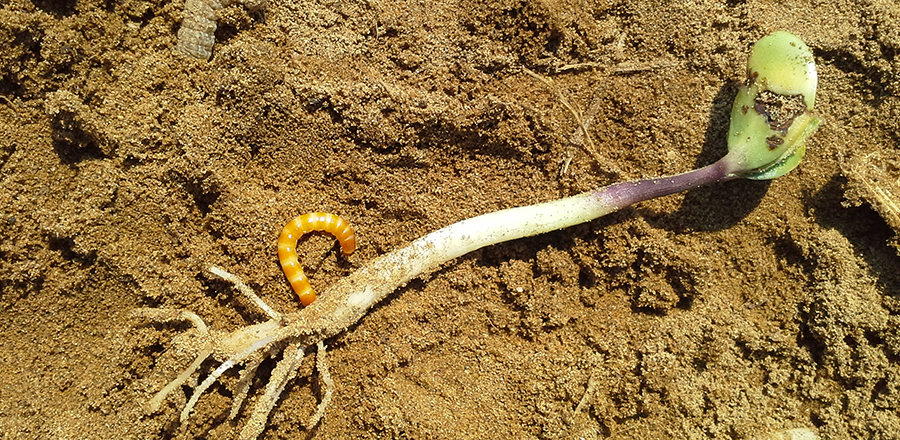Wireworms Have Multi-year Impact
May 16, 2019
A pest that can persist in your soil for years and affect several different crops is wireworm. Soybean growers need to be aware that wireworms can stress the early-season crop through their below-ground feeding habits.
Wireworms are the larvae of click beetles. While the adults don’t damage crops, their presence is a strong indicator of a wireworm problem. Adult click beetles overwinter in the soil and emerge in the early spring, laying hundreds of eggs that are deposited throughout the soil down to a depth of 15 cm. The larvae hatch within three to seven weeks and spend the next three to five years feeding on roots and germinating seeds and moving up and down in the soil profile.
“It’s difficult to differentiate wireworm and white grub damage in soybeans, unless you find the physical culprit nearby,” says Abhi Deora, Seedcare Technical Lead at Syngenta. “Wireworms will feed through the cotelydons, whereas grubs feed only on the roots.” In both cases, the damage can be devastating to soybean stands.
Wireworm baits
Although wireworms never come out of the ground, it is possible to scout for them using a baiting technique shown here. While baits can be a good resource, Deora cautions to be aware of the possibility of the false negative. “These pests love to sit where the moisture is, so they will go down in the soil until they find it. If you don’t have enough moisture in the top layer of the soil, your bait trap might give a false negative result. Also keep in mind that wireworms may not come to the bait trap if other food sources are present, such as volunteer plants, from the previous season.”
For this reason, Deora says it’s best to keep your seed protected from the pest.


Images: Wireworms. The tan or copper-coloured worms are cylindrical and hard-bodied. They vary in size from 1 to 3 cm in length (½ to 1½ inches) and have three pairs of legs near the head end.
Management tips
- Scout fields to identify wilted plants or gaps where there are areas of dead plants. Dig around the plant to look for feeding damage and insect larvae, to confirm the cause of the damage.
- Wireworms can be monitored in the fall (or in the early spring for later-planted crops) using bait stations. A count of 0.5 to 1 wireworm per bait station indicates a potential problem.
Protect your soybeans from below-ground feeding
Early-season protection against pests like wireworms is critical to give your soybeans a strong start. Fortenza® is a new non-neonicotinoid soybean seed treatment that is applied as a commercial seed treatment that protects soybean seeds and seedlings from below-ground insect feeding. It’s formulated with cyantraniliprole (Group 28 insecticide) for control of seedcorn maggot, European chafer, June beetle larvae and wireworm. Even under heavy insect pressure, Fortenza helps producers build a strong soybean stand with faster, more uniform growth.
What other pests could be lurking below ground in your soybean field and putting your young crop at risk? Watch for more articles on seedcorn maggot and white grubs to get to know these damaging pests and plan your defence.
Always read and follow label directions. Fortenza® is a trademark of a Syngenta Group Company. © 2019 Syngenta.